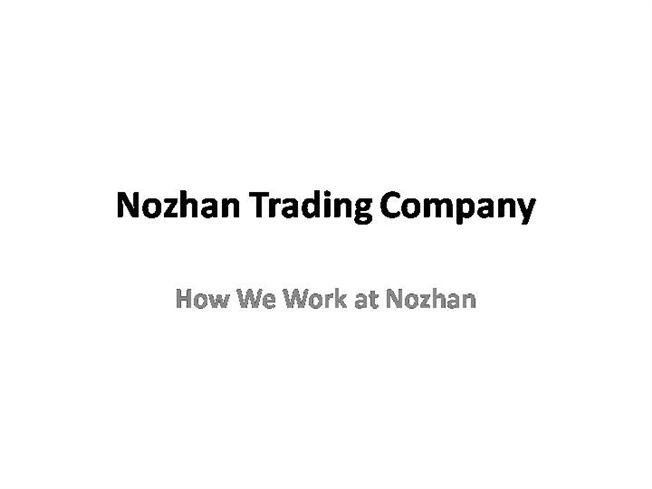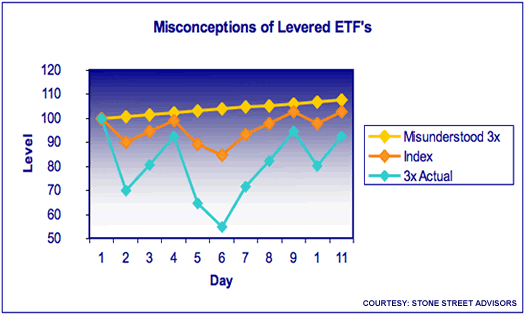Leveraged Inverse ETFs Exotic Risky Options
Post on: 29 Апрель, 2015 No Comment

Might Be Unsuitable for Long-Term Investors
If you’re a day-trader, you may find leveraged and inverse exchange-traded funds useful. If not, you might find they carry excessive risks that could tank your entire investment, warned the Securities and Exchange Commission and Financial Industry Regulatory Authority in a joint release in August.
Leveraged and inverse ETFs are meant to provide an opportunity for investors to profit on the daily movements of the indexes they track, either by seeking to double the daily return or to duplicate or double the opposite of the daily return. Traditional ETFs, on the other hand, simply track stock and bond market indexes in an effort to match their returns. The difference is in the objective.
Despite the risky nature of leveraged ETF strategies, some investors have been lured by strong short-term returns. Unfortunately, these high returns can turn south quickly. In fact, some leveraged ETFs have lost 50 percent to 90 percent of their value in less than six months’ time because the volatile nature of their underlying investments leads to unpredictable returns. A number of brokerage firms, including Fidelity, Ameriprise Financial, Morgan Stanley Smith Barney and UBS Wealth Management Americas, have warned investors about the dangers of these funds, restricted their use or prohibited brokers from soliciting purchases of them.
“Leveraged and inverse ETFs typically are designed to achieve their stated performance objective on a daily basis,” notes the SEC in its release “Leveraged and Inverse ETFs: Specialized Products With Extra Risks for Buy-and-Hold Investors.” “Some investors might invest in these ETFs with the expectation that the ETFs may meet their stated daily performance objectives over the long term as well. Investors should be aware that performance of these ETFs over a period longer than one day can differ significantly from their stated daily performance objectives.”
The ABCs of Leveraged ETFs
Although leveraged and inverse ETFs have certain characteristics in common, they’re also very different. Leveraged ETFs seek to double or triple the return of a particular index daily. Inverse ETFs essentially bet that the relevant indexes will fall instead of rise or rise instead of fall by providing a return that’s exactly opposite or double or triple the opposite return daily.
Because of compounding and leverage, these types of ETFs aren’t meant to deliver long-term returns. This is where individual investors are getting in trouble and why the SEC and FINRA, an independent organization that regulates the brokerage industry, issued their warning.
Companies that sponsor leveraged and inverse ETFs are quite upfront about the funds’ objectives. For example, ProFunds, an ETF sponsor that offers a range of short and inverse ETFs, describes its lineup of inverse ETFs as vehicles that “hedge against downturns, or seek profits when markets decline with the first ETFs designed to go up when indexes go down or down when indexes go up.” In a similar fashion, the company touts its Ultra ProShares lineup — leveraged ETFs — as being a way to “get more exposure for your investment dollars with the first ETFs designed to double the daily performance of popular market indexes (before fees and expenses).”
ProShares, as with other companies that sponsor leveraged and inverse ETFs, warns that “due to the compounding of daily returns, ProShares returns over periods other than one day will likely differ in amount and possible direction from the target return for the same period.” In other words, simple math doesn’t work when it comes to these instruments; if an index has gone down 20 percent during the past six months, an inverse ETF won’t go up 40 percent over the same period. It might have gone up by more or less — and in some cases, much more or much less — but there’s no way to know in advance because returns are so unpredictable.
Differences From Regular ETFs
Traditional ETFs are pretty simple investments. They seek to mirror the returns of a specific market index at a low cost. ETFs track virtually every nook and cranny of the market, from broad indexes such as the Standard & Poor’s 500, which is designed to track the 500 largest publicly traded companies in America, to regional and sector indexes. ETFs have been around for more than 15 years, but they didn’t catch on with retail investors until earlier this decade, when their sponsors touted them as low-cost alternatives to index mutual funds.
ETFs have several advantages over traditional mutual funds. Because ETFs buy the same stocks that are in an index, they don’t need a staff of managers and analysts to decide what stocks, bonds and other securities to have in a portfolio. This is also true of index mutual funds. Unlike mutual funds, which you can buy or sell shares in only at the end of a trading day (when the value of the fund’s holdings, or net asset value, is computed), ETFs can be acquired or sold whenever the market’s open because they trade like stocks. But you have to pay a brokerage commission to buy or sell ETFs, which you don’t have to do with a traditional mutual fund.
Both traditional ETF and index mutual funds track their selected indexes pretty closely. Generally, they’ll underperform their selected index by their expense ratios, which is the percentage of investable assets you pay for fund or ETF management and administrative expenses.

Because they trade during the day, ETFs will have some tracking error against the index. This is because investor demand may push the price of an ETF slightly higher or lower than the actual value of the underlying index. These differences can persist once the market is closed for the day; the amount of the differences depends on the ETF and its underlying index.
So with a traditional ETF, what you see is what you get — performance fairly close to the underlying index. This definitely isn’t true when it comes to leveraged or inverse ETFs, which follow their investment objective daily but don’t promise to — and in fact don’t — on any basis longer than a day, as the table on this page illustrates.
Another difference between traditional ETFs and leveraged and inverse ETFs is cost. Broadly based ETFs carry very low costs, in most cases below 0.25 percent of the assets you hold in the ETF. Traditional ETFs that are more narrowly focused generally have higher costs, on average about 0.5 percent of the assets you hold in an ETF.
Meanwhile, inverse and leveraged ETFs carry much higher costs. Pro-Shares Short and UltraShort ETFs in most cases have an expense ratio of 0.95 percent. The expense ratios or other leveraged and inverse ETF providers range from 0.70 percent to 0.99 percent.
Suitable for Some
Leveraged and inverse ETFs are suitable for a very narrow universe of individual investors — those who trade on a daily basis. If you are a long-term investor who buys and holds ETFs, mutual funds and other investments, think very seriously before investing in these volatile instruments.
Click image to enlarge














